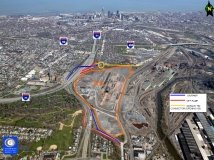Downtown - ODOT Innerbelt Reconstruction


Project: Large interstate reconstruction of the "innerbelt", connecting exchanges, and Cuyahoga river bridge.
Estimated Cost: ~$900 Million
Estimated Date Completion: ~2017
The Ohio Department of Transportation (ODOT) has a number of major projects in the works for Cleveland. There are at least 4 large transportation projects under way that will change the way we get from one place to another. The most significant is undoubtedly the innerbelt reconstruction and Cuyahoga viaduct proposal.
Cleveland's innerbelt (I-90) is a below grade interstate (meaning it's in a big ditch) curving around downtown from the east lakefront to the Cuyahoga river bridge at Tremont. This road serves as an obvious physical boundry for Clevland's downtown. At present this is one of the more dangerous sections of interstate in the state. The Cuyahoga viaduct is also a choke point for interstate traffic from I-90 west and I-71 to downtown resulting in regular delays.
The plan at present has four major pieces. First is flattening out "Deadman's curve" where I-90 takes a sharp turn from north-south to follow Lake Erie. Traffic here is forced to slow down to 35 mph and collisions or tipovers of trucks are a common occurrence. Few Clevelanders anywhere will complain about this improvement (except perhaps for a building owner or two in the area affected). I can't imagine anyone actually likes this turn.
The second improvement is simple general reconstruction of the roadway, street bridges, walls, etc. Not much to complain about there.
The third improvement which is causing some localized opposition is the proposal to reduce the number of interchanges off of I-90 (and rebuild the remaining ones). This opposition should be expected as any business owner would be upset if a major road was moved away from his business. In my opinion, the proposal is generally a good one however. Traffic would definitely move better and major traffic corridors would evolve with fewer interchanges.
The final piece to the puzzle is the one that's bringing out the boo birds from their roosts. The single biggest expense in this project is the construction of one or two new bridges over the Cuyahoga river. Once the general public got a good look at ODOT's first set of plans, and once they thought a bit about the signature bridge being build over the Maumee river in our nearby city of Toledo, the local outcry was heard.
The first plans for the bridge involve an even more curved roadway close to downtown. Perhaps most unfortunate were the highly pedestrian bridge designs proposed for this span or spans. There is nothing exciting in them whatsoever. Opponents to this plan claim that a bridge can be build flattening out the curve in the road, which would have the added effect of increasing the area of downtown hemmed in by the interstate. Perhaps their major complaint involves the bridge type, however. There is much outcry for a signature bridge of the Boston, or even Toledo, type. If we're going to spend half a billion (with a B) dollars on a bridge, let's make it a good one they say. I agree on that aspect. If you're going to build big, you should always try to build beautiful. Construction projects like this have a way of lasting much longer than people anticpate and defining the region for decades to come (if not longer). ODOT may say that the bridge will be in use for 50 years, but in my opinion no one should rationally believe it won't be here a century from now.
The biggest obstacle to the alternative route provided by the ODOT opponents appears to be a rather mundane (albeit *VERY* significant) concern. ODOT does not believe it could keep the bridge open while working on the southern route alternative. It does believe it can keep traffic flowing for its proposal. If true, this absolutely ends the argument. No one in Cleveland can afford to have its most major interstate shut down for 2 years right at the gates of downtown.
If the opponents can disprove this argument, than you can count me in among their supporters. The southern route of the bridge certainly seems to make more sense.
See www.innerbelt.org for the ODOT proposals. See http://planning.co.cuyahoga.oh.us/bridge/ for how the oppositions alternative plans have gelled.




